FUNDAMENTALS OF INSTRUCTING
Knowledge of the fundamentals of instructing is a common requirement
for all flight instructors. The FAA has produced FAA-H-8083-9,
"Aviation Instructor's Handbook" to provide information about this
subject. No one should attempt to take the Fundamentals of Instructing
(FOI) test without having studied this publication. Flight instructor
candidates will find the handbook a valuable source of information
to aid them in developing their skills in instructing as well as in
passing the test. What follows here is a condensed version of FAA-H-8083-9, intended to be used for review of the material prior to taking the test.
Those who wrote the FOI test followed the advice
contained in the manual, "When items are to measure achievement at a
higher level of learning, some or all of the alternatives should be
acceptable responses - but one should be clearly better than the
others". The result is that the correct answer to many of the test
questions requires the applicant to know exactly what the book
says about the subject. Therefore, much of the material presented here is a direct quotation from the FAA book, and is enclosed in quotation marks. Students are advised to pay particular attention to these, since the same or similar words are likely to appear on the test.
LEARNING
We begin with a definition of learning and some of its characteristics.
"Learning can be defined as a change in behavior as a result of experience."
- Learning is purposeful. Students are unlikely to learn unless it is related to their goals.
- It is a result of experience. The student learns from personal experience, but each student's response is conditioned by previous experiences.
- It is multifaceted.
"The learning process may include verbal elements, conceptual elements, perceptual elements, emotional elements, and problem solving elements all taking place at once.
While learning the subject at hand, students may be learning other things as well. This type of learning is sometimes referred to as incidental."
- Learning is an active process. Students need to react and respond; not simply be present during instruction.
PRINCIPLES OF LEARNING
FAA-H-8083-9 lists six principles of learning: Readiness, Exercise, Effect, Primacy, Intensity, and Recency.
-
"If students have a strong purpose, a clear objective, and a definite reason for learning something, they make more progress than if they lack motivation. Readiness implies a degree of single-mindedness and eagerness."
-
"The principle of exercise states that those things most often repeated are best remembered. The instructor must provide opportunities for students to practice and, at the same time, make sure that this process is directed toward a goal."
-
"The principle of effect is based on the emotional reaction of the student. It states that learning is strengthened when accompanied by a pleasant or satisfying feeling, and that learning is weakened when associated with an unpleasant feeling."
-
"Primacy, the state of being first, often creates a strong, almost unshakable, impression. For the instructor, this means that what is being taught must be right the first time."
-
"The principle of intensity implies that a student will learn more from the real thing than from a substitute."
-
"The principle of recency states that things most recently learned are best remembered. The principle of recency often determines the sequence of lectures within a course of instruction."
PERCEPTIONS
Perceptions, received through one or more of the five senses,
"are the basis of all learning."
"Perceiving involves more than the reception of stimuli from the five senses. Perceptions result when a person gives meaning to sensations."
Several factors affect one's perception:
- The pilot's physical organism must respond adequately to stimuli received in flight.
-
"A person's basic need is to maintain and enhance the organized self."
- One's goals and values affect how they perceive things.
-
"Self-concept is a powerful determinant in learning. A student's self-image, described in such terms as confident and insecure, has great influence on the total perceptual process.
If a student has negative experiences which tend to contradict self-concept, there is a tendency to reject additional training."
-
Obviously, one must have time and opportunity to perceive.
-
"The element of threat does not promote effective learning. In fact, fear adversely affects perception by narrowing the perceptual field."
INSIGHT
"Insight involves the grouping of perceptions into meaningful wholes.
It is the mental relating and grouping of associated perceptions."
It will probably happen for the student eventually even without help.
"Instruction, however, speeds this learning process by teaching the relationship of perceptions as they occur.
Pointing out the relationships as they occur, providing a secure and nonthreatening environment in which to learn, and helping the student acquire and maintain favorable self-concept are key steps in fostering the development of insight."
MOTIVATION
"Motivation may be negative or positive, tangible or intangible, subtle and difficult to identify, or it may be obvious.
Negative motivation may engender fear, and be perceived by the student as a threat. Positive motivation is provided by the promise or achievement of rewards.
Students are like typical employees in wanting tangible return for their efforts. For motivation to be effective, students must believe that their efforts will be suitably rewarded. Negative motivation in the form of reproofs or threats should be avoided with all but the most overconfident and impulsive students."
LEVELS OF LEARNING
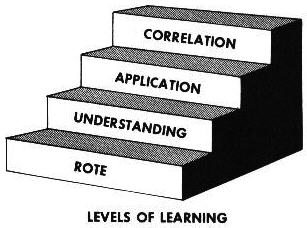 |
There are four basic levels of learning:-
"Rote. The ability to repeat something back which was learned, but not understood."
-
"Understanding. To comprehend or grasp the nature or meaning of something."
-
"Application. The act of putting something to use that has been learned and understood. The student has developed the skill to apply what has been learned. This is a major level of learning, and one at which the instructor is too often willing to stop."
-
"Correlation. Associating what has been learned, understood, and applied with previous or subsequent learning."
|
DOMAINS OF LEARNING
The predecessor to FAA-H-8083-9 was content to stop with the four basic levels of learning just described. The new document has expanded this concept to three domains of learning, each with several levels. If you think this is too much to commit to memory, at least remember the lowest and highest levels and you will get most of the test questions right.
"The listing of the hierarchy of objectives is often called a taxonomy. A taxonomy of educational objectives is a systematic classification scheme for sorting learning outcomes into three broad categories (cognitive, affective, and psychomotor) and ranking the desired outcomes in a developmental hierarchy from least complex to most complex."
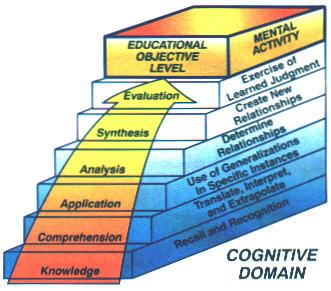 |
"The cognitive domain, described by Dr. Benjamin Bloom, is one of the best known educational domains. It contains additional levels of knowledge and understanding and is commonly referred to as Bloom's taxonomy of educational objectives."
|
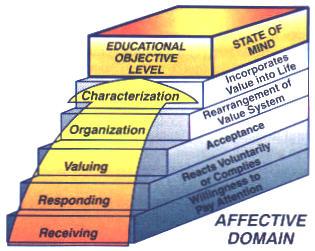 |
"Since the affective domain is concerned with a student's attitudes, personal beliefs, and values, measuring educational objectives in this domain is not easy."
|
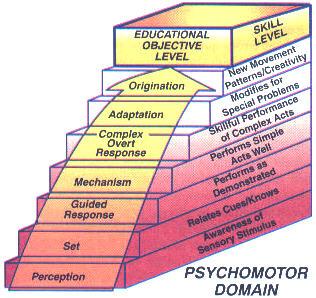 |
This domain deals with learning and the physical skills. |
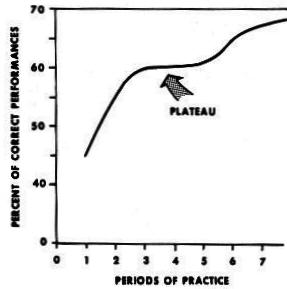 |
LEARNING PLATEAU
"The best way to prepare a student to perform a task is to provide a clear, step-by-step example." Although the concept of a learning plateau applies to all learning, it is particularly applicable to learning physical skills.
"Graphs of the progress of skill learning usually follow the same pattern. There is rapid improvement in the early stages, then the curve levels off and may stay level for a significant period of time.
In planning for student performance, a primary consideration is length of time devoted to practice." |
MEMORY
Memory is, of course, an integral part of learning. It can be divided into three different segments:
-
"The sensory register receives input from the environment and quickly processes it according to the individual's preconceived concept of what is important."
-
"The working or short term memory is not only time limited, it also has limited capacity." It sorts and categorizes the information it receives in a process called coding. "The coding process is more useful in a learning situation. In addition, the coding process may involve recoding to adjust the information to individual experiences. Therefore, recoding may be described as a process of relating incoming information to concepts or knowledge already in memory. Methods of coding vary with subject matter, but typically they include some type of association. Use of rhymes or mnemonics is common."
-
"What then is distinctive about the long-term memory? This is where information is stored for future use."
FORGETTING
Just because something was stored in long-term memory doesn't guarantee that you can recall it now. There are several reasons why we forget information we once knew:
-
"The theory of disuse suggests that a person forgets those things which are not used."
-
"The basis of interference theory is that people forget something because a certain experience has overshadowed it, or that the learning of similar things has intervened."
-
"Some forgetting is repression due to submersion of ideas into the subconscious mind."
REMEMBERING
There are also factors that aid in remembering:
-
PRAISE STIMULATES REMEMBERING
"Responses which give a pleasurable return tend to be repeated. Absence of praise or recognition tends to discourage, and any form of negativism in the acceptance of a response tends to make its recall less likely."
- RECALL IS PROMOTED BY ASSOCIATION It is easier to remember something that is associated with something else, than to remember an isolated fact.
- FAVORABLE ATTITUDES AID RETENTION People remember only what they wish to know.
- LEARNING WITH ALL OUR SENSES IS MOST EFFECTIVE Most of what we learn is through our eyes and ears, but the more senses that are involved in learning the easier it is to remember.
- MEANINGFUL REPETITION AIDS RECALL Repetition helps fix learning in memory, but after too much (perhaps as few as three or four repetitions), the benefits tend to decline.
LEARNING TRANSFER
"During a learning experience, the student may be aided by things learned previously. Sometimes, previous learning interferes with the current learning task. If the learning of skill A helps to learn skill B, positive transfer occurs. If learning A hinders learning B, negative transfer occurs."
"Due to the high level of knowledge and skill required in aviation, training traditionally has followed a building block concept. This means new learning and habit patterns are based on a solid foundation of experience and/or old learning.
Instruction has taken place when the instructor has explained a particular procedure and subsequently determined that the desired student response has occurred."
HIERARCHY OF NEEDS
Students, like all human beings, are subject to a hierarchy of human needs. An instructor is wasting time concentrating on a higher need before a lower one is fulfilled. These needs are usually depicted as a pyramid with the lower level needs at the bottom and progressively higher needs above:
 |
-
PHYSICAL -
"At the bottom of the pyramid is the broadest, most basic category, the physical needs. Each person is first concerned with a need for food, rest, and protection from the elements. Until these needs are satisfied, a person cannot concentrate fully on learning."
- SAFETY -
Satisfying this need may challenge the instructor when introducing stalls.
- SOCIAL -
"When individuals are physically comfortable and do not feel threatened, they seek to satisfy their social needs."
- EGO -
These needs may relate to the student's self-esteem or to the student's reputation.
- SELF-FULFILLMENT -
"Self-fulfillment for a student should offer the greatest challenge to the instructor."
|
DEFENSE MECHANISMS
Students may resort to defense mechanisms to protect their egos when their progress is not satisfactory. Several of these may apply, either alone or in combination:
-
COMPENSATION Students sometimes try to hide weakness by emphasizing their strengths. As a pilot examiner, I have frequently found applicants answering the question they wished I had asked, rather than the one I did ask. It rarely works, but it's worth a try when you don't know the desired answer.
-
PROJECTION A poor workman blames his tools. Students may try to shift the responsibility for their mistakes to someone or some thing else.
-
RATIONALIZATION
"If students cannot accept the real reasons for their behavior, they may rationalize. This device permits them to substitute excuses for reasons."
-
DENIAL OF REALITY Students may refuse to acknowledge disagreeable realities.
-
REACTION FORMATION This is the "who-cares-how-other-people-feel" attitude.
-
FLIGHT
"Students often escape from frustrations by taking flight, physical or mental."
-
AGGRESSION
"Because of safety concerns or social strictures, student aggressiveness may be expressed in subtle ways. They may ask irrelevant questions, refuse to participate in activities of the class."
-
RESIGNATION
"More frequent than physical flights are mental flights, or daydreaming.
The most obvious and apparent cause for this form of resignation takes place when, after completing an early phase of a course without grasping the fundamentals, a student becomes bewildered and lost in the more advanced phases."
"Since defense mechanisms involve some degree of self-deception and distortion of reality, they do not solve problems; they alleviate symptoms, not causes."
ANXIETY
"Anxiety can be countered by reinforcing students' enjoyment of flying, and by teaching them to cope with their fears. An effective technique is to treat fears as a normal reaction, rather than ignoring them."
"When a threat is recognized or imagined, the brain alerts the body. Normal individuals begin to respond rapidly and exactly, within the limits of their experience and training."
Abnormal reactions to stress may include:
- "Inappropriate reactions, such as extreme over-cooperation, painstaking self-control, inappropriate laughter or singing, and very rapid changes in emotions."
-
Marked changes in mood on different lessons
- Severe anger
COMMUNICATION
Effective Communication between the instructor and student is essential for learning to result.
"Communication takes place when one person transmits ideas or feelings to another person or group of people. Its effectiveness is measured by the similarity between the idea transmitted and the idea received."
There are three basic elements in communication: the source (instructor), the symbols (primarily words), and the receiver (student).
"An instructor is more likely to communicate effectively if material is accurate, up-to-date, and stimulating."
"In addition to using the correct symbols to communicate effectively, the instructor must reveal a positive attitude while delivering a message."
"When students react with understanding and change their behavior according to the intent of the instructor, effective communication has taken place."
"To gain and hold students' attention, attitudes should be molded into forms that promote reception of information. A varied communicative approach will succeed best in reaching most students since they all have different attitudes."
BARRIERS TO COMMUNICATION
The instructor should be aware of several barriers to effective communication:
-
"Lack of common experience between instructor and student is probably the greatest single barrier to effective communication.
A communicator's words cannot communicate the desired meaning to another person unless the listener or reader has had some experience with the objects or concepts to which these words refer."
-
Instructors should be alert for confusion between the symbol and the symbolized object. Words and other symbols may have different meaning to different students.
-
Overuse of abstractions, as opposed to more specific terms, may fail to convey the intended message to all students.
"Abstract words stand for ideas that cannot be directly experienced, things that do not call forth mental images in the minds of the students.
The danger of abstractions is that they will not evoke the same specific items of experience in the minds of students that the instructor intends."
-
The instructor should be alert for interference - physiological, environmental, or psychological - even though it may be beyond the direct control of the instructor.
TEACHING
"The teaching of new material can be reduced to preparation, presentation, application, and review and evaluation."
-
Preparation includes determining the objective of the lesson, and the criteria by which its achievement will be measured.
-
The instructor may choose from several methods of presentation.
"The lecture method is suitable for presenting new material, for summarizing ideas, and for showing relationships between theory and practice."
"The demonstration-performance method is desirable for teaching a skill, such as a ground school lesson on the flight computer, or during instruction on most flight maneuvers." -
"Application is where the student uses what the instructor has presented."
-
"Evaluation is an integral part of each classroom, shop, or flight lesson.
Failure to make students aware of their progress, or lack of it, may create a barrier that could impede further instruction.
The evaluation of student performance and accomplishment during a lesson should be based on the objectives and goals that were established in the instructor's lesson plan."
TEACHING METHODS
Regardless of the teaching method the instructor chooses, the lesson plan should be organized to include introduction, development, and conclusion.
-
"The introduction sets the stage for everything to come. Efforts in this area pay great dividends in terms of quality of instruction. In brief, the introduction is made up of three elements - attention, motivation, and an overview of what is to be covered."
-
"Development is the main part of the lesson. Here, the instructor develops the subject matter in a manner that helps the students achieve the desired learning outcomes.
The instructor must logically organize the material to show the relationships of the main points in one of the following ways: from past to present, simple to complex, known to unknown, and most frequently used to least frequently used.
By using something the student already knows as the point of departure, the instructor can lead into new ideas and concepts."
-
The conclusion is a review of the material that has already been presented.
LECTURE
The lecture method of presenting information is an important tool for the instructor.
"In the teaching lecture, the instructor must develop a keen perception for subtle responses from the class - facial expressions, manner of taking notes, and apparent interest or disinterest in the lesson. The successful instructor will be able to interpret the meaning of these reactions and adjust the lesson accordingly."
"The following four steps should be followed in the planning phase of preparation:
- Establishing the objective and desired outcomes;
- Researching the subject;
- Organizing the material; and
- Planning productive classroom activities."
"Errors in grammar and vulgarisms detract from an instructor's dignity and reflect upon the intelligence of the students."
"The informal lecture includes active student participation.
The instructor can achieve active student participation in the informal lecture through the use of questions."
"Lecturing is unquestionably the most economical of all teaching methods in terms of the time required to present a given amount of material."
GROUP LEARNING
"Cooperative or group learning is an instructional strategy which organizes students into small groups so they can work together to maximize their own and each other's learning.
Perhaps the most significant characteristic of group learning is that it continually requires active participation of the student in the learning process.
The main advantages with heterogeneous groups are that students tend to interact and achieve in ways and at levels that are rarely found with other instructional strategies."
"The main reason that students are put in cooperative learning groups is so they can individually achieve greater success than if they were to study alone."
GUIDED DISCUSSION
"In the guided discussion, learning is achieved through skillful use of questions.
The overhead question is directed to the entire group to stimulate the thought and response from each group member."
"Unless the students have some knowledge to exchange with each other, they cannot reach the desired learning outcomes by the discussion method."
"Plan at least one leadoff question for each desired learning outcome. In preparing questions, the instructor should remember that the purpose is to stimulate discussion, not merely to get answers. The instructor should avoid questions that require only short categorical answers, such as yes or no. Lead-off questions usually begin with how or why.
When it appears the students have discussed the ideas that support this particular part of the lesson, the instructor should summarize what the students have accomplished."
DEMONSTRATION-PERFORMANCE
"The demonstration-performance method of teaching has five essential phases: Explanation; Demonstration; Student Performance; Instructor Supervision; and Evaluation."
Student Performance and Instructor Supervision involve separate actions but are performed concurrently. "The first of these phases is the student's performance of the physical or mental skills that have been explained and demonstrated. The second activity is the instructor's supervision"
COMPUTER BASED TRAINING
One of the newer training methods now available to instructors is Computer Based Training (CBT).
"One of the major advantages of CBT is that students can progress at a rate which is comfortable for them.
Some of the more advanced CBT applications allow students to progress through a series of interactive segments where the presentation varies as a result of their responses.
The major advantage of CBT over other forms of instructional aid is that it is interactive - the computer responds in different ways, depending on the student's input."
CRITIQUE AND EVALUATION
Critique and Evaluation have a lot in common, but they serve very different purposes.
"A critique may be oral, written, or both. It should come immediately after a student's performance, while the details of the performance are easy to recall.
Two common misconceptions about the critique should be corrected at the outset. First, a critique is not a step in the grading process. It is a step in the learning process.
A critique should provide the students with something constructive upon which they can work or build. It should provide direction and guidance to raise their level of performance."
Some of the characteristics of an effective critique are:
- Objective - The critique must be based on an unbiased assessment of the student's performance.
- Flexible - "An effective critique is one that is flexible enough to satisfy the requirements of the moment."
- Acceptable - "Before students willingly accept their instructor's criticism, they must first accept the instructor. Students must have confidence in the instructor's qualifications, teaching ability, sincerity, competence, and authority."
- Comprehensive - "An effective critique covers strengths as well as weaknesses."
- Constructive - Whether comments are positive or negative they should be aimed at improving performance.
- Organized - The critique should be organized in a way that is understandable by the student.
- Thoughtful - The student's personal feelings must always be respected.
- Specific - Desired improvement must be accurately specified.
ORAL QUIZZES
Evaluation determines how a student is progressing. It may be in the form of oral quizzes, written tests, or performance tests.
ORAL QUIZZES may include fact questions or thought questions.
"The answer to a fact question is based on memory or recall. This type of question usually concerns who, what, when, and where. Thought questions usually involve why or how, and require the student to combine knowledge of facts with an ability to analyze situations, solve problems, and arrive at conclusions."
"Proper quizzing:
- Reveals the effectiveness of the instructor's training procedures
- Checks the student's retention of what has been learned
- Reviews material already covered by the student
- Can be used to retain the student's interest and stimulate thinking
- Emphasizes the important points of training
- Identifies points that need more emphasis
- Checks the student's comprehension of what has been learned
- Promotes active student participation, which is important to effective learning."
"An effective question should be brief and concise, but also clear and definite.
To be effective, questions must be adapted to the ability, experience, and stage of training of the students.
The question must be clearly understood by the instructor before an answer is attempted."
WRITTEN TESTS
Good WRITTEN TESTS share the following characteristics:
-
"Reliability is the degree to which test results are consistent with repeated measurements."
-
"Validity is the extent to which a test measures what it is supposed to measure."
-
Usability refers to how easy it is to administer the test.
-
Objectivity means that the scoring of the test is not influenced by the biases of the scorer.
-
"Comprehensiveness is the degree to which a test measures the overall objectives. The instructor has to make certain that the evaluation includes a representative and comprehensive sampling of the objectives of the course."
-
"Discrimination is the degree to which a test distinguishes the difference between students."
"Criterion-referenced testing evaluates each student's performance against a carefully written, measurable, standard or criterion. The FAA knowledge and practical tests for pilots and aircraft maintenance technicians are all criterion referenced.
A pretest is a criterion-referenced test constructed to measure the knowledge and skills that are necessary to begin the course."
Written test questions can be Supply-type, where the student responds with a word, sentence, or paragraph; or Selection-type, where the student selects from two or more alternatives.
"The main disadvantage of supply-type tests is that they cannot be graded with uniformity.
The same test graded by different instructors would probably be assigned different scores."
"Written tests made up of selection-type items are highly objective. That is, the results of such tests would be graded the same regardless of the student taking the test or the person grading it." There are several kinds of selection-type questions:
-
"The chief disadvantage is that true-false questions create the greatest probability of guessing."
-
Multiple-Choice questions consist of a stem that contains the question, and a list of possible responses, most of which are incorrect answers called distractors.
"The distractors must be written in such a way that they will be attractive to those students who do not possess the knowledge or understanding necessary to recognize the keyed response."
"When items are to measure achievement at a higher level of learning, some or all of the alternatives should be acceptable responses - but one should be clearly better than the others."
Some principles to be considered when constructing multiple-choice questions are:
"Design questions that call for essential knowledge rather than for abstract background knowledge or unimportant facts. When a negative is used, emphasize the negative word or phrase by underlining, bold facing, italicizing, or printing in a different color." -
A matching test item consists of two lists. The student is required to match items in the lists.
"Matching reduces the probability of guessing correct responses, especially if alternatives may be used more than once."
"Performance testing is desirable for evaluating training that involves an operation, a procedure, or a process." It is the kind of testing utilized in the Practical Test Standards (PTS).
"The objective of the PTS is to ensure the certification of pilots at a high level of performance and proficiency, consistent with safety."
INSTRUCTIONAL AIDS
Instructional aids are supplementary devices used to assist the instructor.
"Instructional aids should be designed to cover the key points and concepts.
The use of any instructional aid must be planned, based on its ability to support a specific point in a lesson. A simple process can be used to determine if and where instructional aids are necessary. Clearly establish the lesson objective. Be certain of what is to be communicated.
Aids should be simple and compatible with the learning outcomes to be achieved.
The instructor should avoid the temptation to use the aids as a crutch."
INSTRUCTOR RESPONSIBILITIES
Aviation Instructor Responsibilities include:
-
Helping Students Learn
"Learning should be an enjoyable experience. By making each lesson a pleasurable experience for the student, the instructor can maintain a high level of student motivation.
Not knowing the objective of the lesson often leads to confusion, disinterest, and uneasiness on the part of the student."
- Providing Adequate Instruction The instructor should adapt the instruction to the student's personality, thinking, and ability.
"Students who are fast learners can also create problems for the instructor. Because they make few mistakes, they may assume that correction of errors is unimportant. Such overconfidence may soon result in faulty performance. For such students, the instructor should constantly raise the standard of performance for each lesson, demanding greater effort."
- Demanding Adequate Standards of Performance
"Instructors fail to provide competent instruction when they permit their students to get by with a substandard performance, or without learning thoroughly some item of knowledge pertinent to safe piloting."
- Emphasizing the Positive A first flight lesson could emphasize the risks of flight and the consequences of carelessness.
"In contrast, consider a first flight lesson in which the preflight inspection is presented to familiarize the student with the airplane and its components, and the flight consists of a perfectly normal flight to a nearby airport and return.
It illustrates the positive approach in which the student is not overwhelmed with the critical possibilities of aviation before having an opportunity to see its potential and pleasurable features. The introduction of emergency procedures after a student has developed an acquaintance with normal operations is not so likely to be discouraging and frightening, or to inhibit learning by the imposition of fear."
Additional Responsibilities for Flight Instructors include:
"Evaluation of demonstrated ability during flight instruction must be based upon established standards of performance, suitably modified to apply to the student's experience and stage of development as a pilot.
In evaluating student demonstrations of piloting ability, it is important for the flight instructor to keep the student informed of progress."
"Before endorsing a student for solo flight, the instructor should require the student to demonstrate consistent ability to perform all of the fundamental maneuvers. The student should also be capable of handling ordinary problems that might occur, such as traffic pattern congestion, change in active runways, or unexpected crosswinds.
Examples of all common endorsements can be found in the current issue of AC 61-65, Appendix 1."
PROFESSIONALISM
"Professionals must be true to themselves and to those they service. Anything less than a sincere performance is quickly detected, and immediately destroys their effectiveness.
True performance as a professional is based on study and research.
Professional aviation instructors must never become complacent or satisfied with their own qualifications and abilities. They should be constantly alert for ways to improve their qualifications, effectiveness, and the services they provide to students."
"When students can see the benefits or purpose of a lesson or course, their enjoyment and their efforts will increase.
Students feel insecure when they do not know what is expected of them or what is going to happen to them. Instructors should keep students informed in various ways, including giving them an overview of the course, keeping them posted on their progress, and giving them adequate notice of examinations, assignments, or other requirements.
If a student has made an earnest effort but is told that the work is unsatisfactory, with no other explanation, frustration occurs."
"If the instructor tries to cover up or bluff, the students will be quick to sense it. Such behavior tends to destroy student confidence."
TELLING AND DOING
The Telling and Doing Technique is an effective method for teaching physical skills such as flying an aircraft. It consists of the following steps:
- Preparation
-
Instructor Tells/Instructor Does
- Student Tells/Instructor Does
- Student Tells/Student Does
- Student Does/Instructor Evaluates.
INTEGRATED FLIGHT INSTRUCTION
Integrated flight instruction involves teaching students to perform flight maneuvers using both outside visual references and flight instruments.
"The continuing observance and reliance upon flight instruments is essential for efficient, safe operations. The habit of monitoring instruments is difficult to develop after one has become accustomed to relying almost exclusively on outside references."
"The conduct of integrated flight instruction is simple. The student's first briefing on the function of the flight controls should include the instrument indications to be expected, as well as the outside references which should be used to control the attitude of the airplane."
"The instructor must be sure that the students develop, from the start of their training, the habit of looking for other traffic at all times."
OBSTACLES TO LEARNING
Some obstacles to learning during flight instruction are:
-
Feeling of unfair treatment - The student should feel that challenging but reasonable goals are assigned by the instructor.
- Impatience to proceed to more interesting operations - "Impatience is a greater deterrent to learning pilot skills than is generally recognized.
The instructor can correct student impatience by presenting the necessary preliminary training one step at a time, with clearly stated goals for each step."
- Worry or lack of interest - Worry may stem from outside flight training, but the instructor cannot ignore it.
- Physical discomfort, illness, and fatigue -
"Fatigue is the primary consideration in determining the length and frequency of flight instruction periods."
- Apathy due to inadequate instruction -
"Students quickly become apathetic when they recognize that the instructor has made inadequate preparations for the instruction being given, or when the instruction appears to be deficient, contradictory, or insincere."
- Anxiety -
"Anxiety may place additional burdens on the instructor. This frequently limits the student's perceptive ability and retards the development of insights."
PLANNING INSTRUCTION
Unless the instructor is working for an established school, it may be necessary to expend considerable effort in planning instructional activity.
"Before any important instruction can begin, determination of objectives and standards is necessary.
After the overall training objectives have been established, the next step is the identification of the blocks of learning which constitute the necessary parts of the total objective.
Extraneous blocks of instruction are expensive frills, especially in flight instruction, and detract from, rather than assist in, the completion of the final objective."
"Training for any such complicated and involved task as piloting or maintaining an aircraft requires the development and assembly of many segments or blocks of learning in their proper relationships. In this way, a student can master the segments or blocks individually and can progressively combine these with other related segments until their sum meets the overall training objectives.
The lesson should include three key parts - the objective, the content, and the completion standards."
SYLLABUS
A syllabus is a summary of a course of training. It defines blocks of learning arranged in a logical order. Each lesson is summarized in three parts - the objective, the content, and the completion standards.
"It is often preferable to skip to a completely different part of the syllabus when the conduct of a scheduled lesson is impossible, rather than proceeding to the next block, which may be predicated completely on skills to be developed during the lesson which is being postponed."
LESSON PLAN
"A lesson plan is an organized outline for a single instructional period.
Lesson plans help instructors keep a constant check on their own activity, as well as that of their students."
"Each lesson should contain new material. However, the new facts, principles, procedures, or skills should be related to the lesson previously presented.
Every lesson, when adequately developed, falls logically into the four steps of the teaching process - preparation, presentation, application, and review and evaluation."
"The instructor may find that the procedures outlined in the lesson plan are not leading to the desired results. In this situation, the instructor should change the approach. There is no certain way of predicting the reaction of different groups of students. An approach that has been successful with one group may not be equally successful with another.
The main concern in developing a lesson plan is the student."
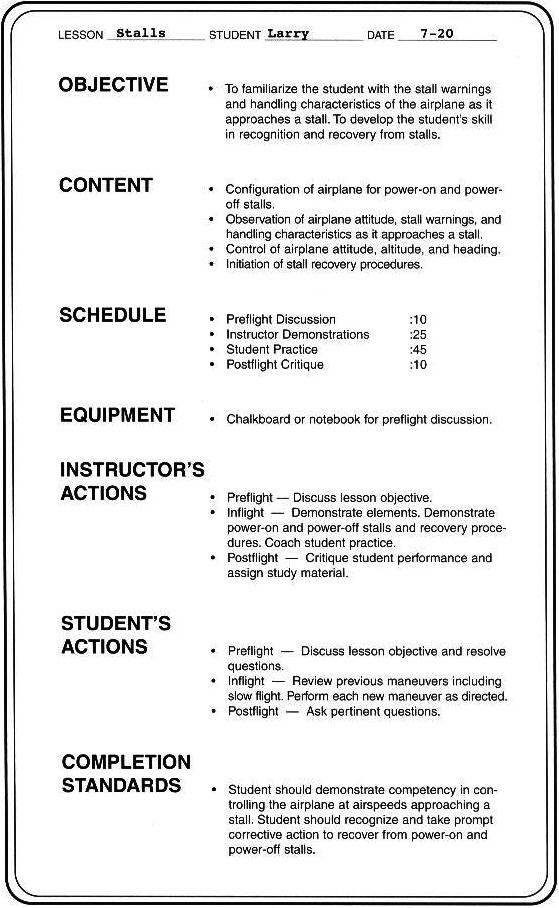
© 2005 Jim D. Burch 602-942-2734
jdburch@att.net
To return to table of contents select TOC






